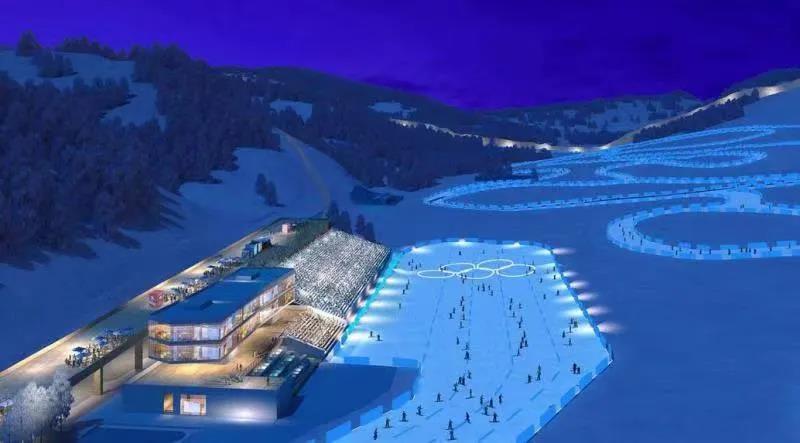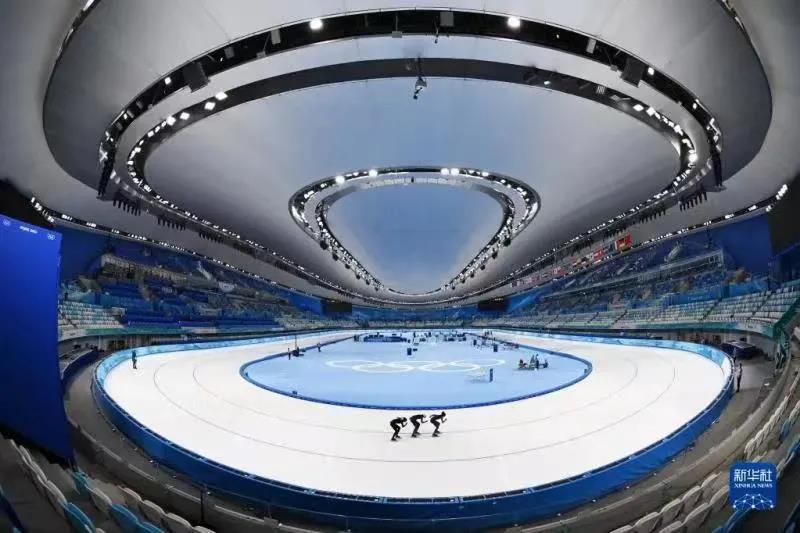Guangming Daily
February 2, 2022
By Liu Jiangwei, Li Xiao and Li Yuan
Beijing, as a city that held a successful Summer Olympics in 2008, is ready to host the 2022 Winter Olympic and Paralympic Games during the Spring Festival.
As the world’s first city to host both the Summer Olympics and the Winter Olympics, Beijing is confident to deliver a fantastic, extraordinary and excellent Winter Olympics in the most difficult circumstances amid the COVID-19 pandemic.

Chinese Culture and Olympics
It is a happy coincidence that the Winter Olympics this year takes place at a special time in China - the traditional Spring Festival. As a national time for celebration, the festive atmosphere has also found its way into the Olympic Village. Within sight are traditional decorations such as red lanterns, Chinese paper-cuts and Spring Festival scrolls; traditional food such as dumplings are also offered in the cafeterias. The special timing of the event this year seems to tell one truth: the Olympics is never just a game of sports but an opportunity for cultures to meet and interact.
Back in 2008 when the Summer Olympics was held in Beijing, the then IOC President Rogge exclaimed that the 2008 Beijing Olympics was not only a chance for the East and the West to come together, but also a chance for the world to explore the unique Chinese culture. Indeed, the official designs for the 2008 Games, including the emblem “Dancing Beijing” and the mascot “Fuwa”, all drew on various elements of Chinese culture and gave the world a glimpse into the country’s rich cultural inheritance.
Such tradition has been carried on in the 24th Winter Olympics. Chinese cultural elements have been fully incorporated in the design of several venues, including National Snowmobile and Sled Center ( “Snow Dragon”), National Alpine Ski Center (“Snow Swallow”), and National Speed Skating Oval (“Ice Ribbon”). The track shape of the Shougang Ski Jumping Platform (“Snow Feitian”) is also inspired by the murals in the Dunhuang Caves, part of an ancient heritage site located in the northwest of China.
Aside from venues, various other designs for the Games have all embodied distinct Chinese features. The official emblem draws on the art form of traditional seal-cutting and resembles the Chinese character for “winter”; the mascots Bing Dwen Dwen and Shuey Rhon Rhon take the images of a panda and a red lantern; the uniforms of the Chinese teams draw inspirations from the traditional landscape painting; and the design of the medals echoes the traditional jade pendant, together with decorations of snow and cloud patterns.
Yet, the biggest display of the Chines elements would be from the Chinese sports team. While competing for their own country, many Chinese athletes have also taken it as an opportunity to show the world China’s unique culture. Peng Cheng and Jin Yang, two figure skaters for example, have selected a piece of traditional Chinese music for their pair skating performance. “We want to convey Chinese cultural values and tell a Chinese story to the world”, said Jin.
A Green Olympics
Beijing has promised to host a “green” and “low-carbon” Olympics. As President Xi has emphasized, energy-saving and environment protection have become the key words for the 24th Beijing Winter Olympics.
As the main venue for the snow events, Chongli, Zhangjiakou, has seen an increase of its forest coverage rate to 67%, and 80% green coverage rate in its central Olympic areas. The 12,000-square-meter Speed Skating Oval has adopted CO2 transcritical cooling technology for producing ice, leading to close-to-zero carbon emission, the first time in the history of Winter Olympics. The Olympic torches are all filled with hydrogen fuel; corn, potatoes and other renewable resources are used to produce biodegradable tableware; and an all-electronic ticket system has been introduced to reduce paper consumption.
“In hosting a ‘Green Olympics’, China has not only lived up to its original promise, but also provided a model of sustainability for future games.” Said Samaranch Jr, Chairman of the IOC Beijing Winter Olympic Coordination Committee.
China’s focus on being green goes further beyond the current designs and constructions- the recycling of Olympic venues is also a central concern for the organizing committee. How to make sure that the venues built for the Games do not serve a one-time purpose only? The answer is to make plans from an early start. The idea of recycling was considered during the initial designing of each venue, taking into account the needs from both during and after the Games. As a result, each venue will have a tailor-made plan for its post-Olympic serving. Furthermore, a lot of venues for this year’s games are themselves recycled- 11 out of the 13 Beijing Venues, including the “Ice Cube” and the Wukesong Arena, have already served in the 2008 Games. Besides saving costs, these old Olympic spots also trigger tourists a feeling of “revisiting the past”.

As is put by Anthony Edgar, a senior specialist in media operations for the Beijing Winter Olympics, “The Games is not the sole purpose of China’s effort. Beyond that is the legacy it leaves after the Games.”
Safe, sound and secure Games
While the sudden hit of the pandemic posed doubts on whether the 2022 Winter Olympics would take place as promised, Beijing delivered to the world a message of reassurance. As the organizing work went on as scheduled, IOC President Bach believed that a strong signal had been sent to the world that the sports community was ready to recover from the crisis, and contribute to a better and more inclusive future.
China has made full preparations to ensure a safe and secure Games. December 13th, 2021 saw the release of the second edition of the “Epidemic Prevention Manual for the 2022 Beijing Winter Olympic and Paralympic Games”, covering everything from vaccinations, customs entry requirements, airline reservations, accommodation, transportation, and nucleic acid testing.
“I’ve been worried about how to make sure I don’t get infected before the Winter Olympics starts,” Said Austrian Snowboarding Olympic champion Anna Gasser, “As soon as we get to Beijing, we feel that we are in the safest place.”
What awaits in Beijing is not only a safe environment, but also the services in the Olympic Village. The Winter Olympics menu with a rich variety of options has gone viral on the internet. The menu, which contains a total of 678 dishes, was scientifically designed by the catering team, going through a string of rigorous procedures: safety risk, nutrition and calory in-take have all been repeatedly tested in order to suit the needs of different sports teams. An all-through corridor was built to enable the travelling of athletes by keeping them warm; each room is equipped with two bedding sets together with an electric heater; and the memory foam mattresses secure the sports teams good nights’ sleep.
Furthermore, a well-trained team of volunteers is ready. From airport receptions to guides and assistants in various venues, this team of volunteers with bright smiles are doing their best to contribute to this world event. They are the warmest light of the Winter Olympics.
From 2008 to 2022, Beijing again becomes the world’s focus for hosting the Olympics. While carrying on its 2008 legacies, the city is ready to exceed the new expectations of the world, and deliver a streamlined, safe and splendid Olympics at the beginning of the year 2022.
Rewritten by Wang Yizeng and Tao Youlan, Fudan University
Source: FDU外院


